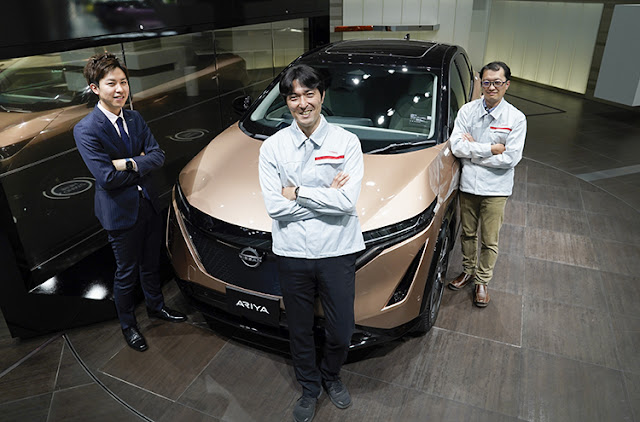 |
| The power of touch. How Nissan defined our interaction with cars. |
What is haptic? According to the Oxford dictionary, it is the use of technology that simulates the senses of touch and motion, especially to reproduce in remote operation the sensations that would be felt by a user interacting directly with physical objects.
Text and Photos from https://philippines.nissannews.com/
When developing the all-new Nissan Ariya electric crossover, its designers and engineers didn't just consider the ergonomics involved in reaching toward the dashboard. They were determined to create a new look and feel for controls that drivers generally take for granted. This required a rethink of cabin space, touch, and positioning.
The Ariya's interior was crafted to be an open, spacious cabin offering a sense of calm and serenity. Part of that design is a dashboard free of traditional buttons. The stylish wood-grained trim bisecting the dashboard comes to life upon starting the Ariya, illuminating a set of environmental controls that reside just beneath the dashboard's surface. Utilizing a new generation of haptic feedback controls, these subtly integrated buttons open a world of possibilities in the relationship between function and design.
 |
| Open spacious cabin |
In the same way that we interact with a smartphone display to navigate and engage with apps, haptic feedback buttons in the Ariya react to touch, communicating through fingertip vibrations. When adjusting the Ariya's climate controls and drive modes, drivers will interact with a familiar set of icons. Yet, because the points of interaction are felt and heard, they can remain focused on the road. The design team's decision to integrate haptic feedback into the Ariya speaks to the vehicle's underlying design concept of Timeless Japanese Futurism, which takes a distinctive Japanese approach to design, conveying a simple yet powerfully modern impression.
 |
| Timeless Japanese Futurism |
Senior Designer Hideki Tago explains: "We created a clean space by blending the haptic controls with the grain of the interior's wood grain finish. We did this in a way that didn't affect the performance of the controls, allowing us to achieve both functionality and an attractive appearance."
"By applying a wood grain pattern to the plastic panels with a hydro-printing process, we gave them a very realistic wood-like feeling. At the same time, this allowed transparent icons to come to life when illuminated.
With the Ariya design team's final goal laid out, it was the engineering team's responsibility to make this sci-fi concept a reality. The process began with an exhaustive breakdown of the technology itself.
Haptic feedback buttons are grouped into two specific areas in the Ariya — on the main dashboard and on the adjustable center armrest. The goal was to not only integrate the technology into the cabin design as a means of wowing passengers but also to give the technology a natural and responsive feel for a wide variety of drivers.
Following extensive testing, the team settled on electrostatic buttons that are not only bigger than traditional haptic controls but also more broadly spaced. This allows for a realistic and intuitive feeling for users, and also generates a kind of air pressure "kick". This amplifies the tactile feedback with the click sensation of a traditional mechanical button, despite no traditional physical button being involved.
Then came the fine-tuning of the vibrations and sounds. That's right — sounds. "Vibration and sound are inseparable," explains Tomotaka Igarashi, the engineer in charge of the Ariya's interior HMI development. "It may seem obvious, but this challenged our team to develop a unique sound that would match the expectations of the driver while also designing it to be as pleasant as possible."
Such attention to detail in an all-electric crossover is, of course, a necessity, as the minimal sound emitted by the electric powertrain means that the sounds developed by the team will be clearly heard while driving. The development of the haptic controls required that every possible scenario be tested repeatedly to ensure easy use for a wide range of drivers. That meant extensive testing by people with different size fingers and fingernail lengths, and with different button-pressure strengths and engagement angles. Gloved hands were also tested to ensure button activation.
This is just one example of how design and function have been woven into the Ariya's development from the outset to deliver a wholly unique driving experience and level of interaction.
 |
Tomotaka Igarashi (center) and HMI and design engineering members with the all-new Nissan Ariya |















You will first want to decide of the car you want to get into. Depending on your choice, it may be easier or more difficult to find the car in exotic car rental Exotic Car Rental
ReplyDelete